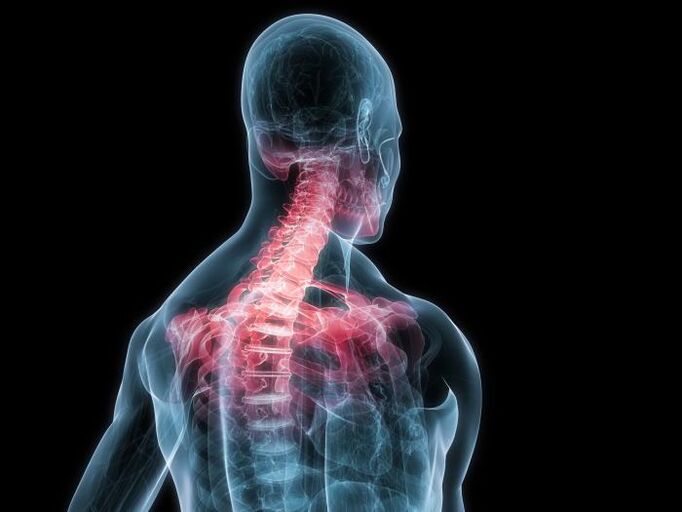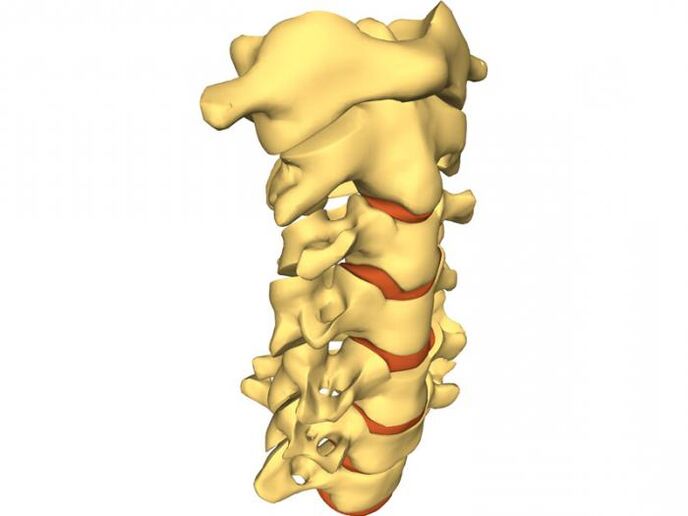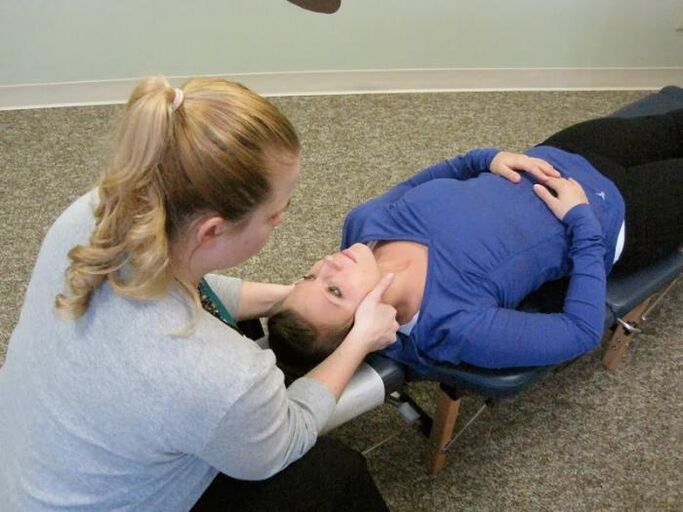Osteochondrosis of the cervical spine is one of the most dangerous types of neurological diseases. What is this disease, how is it manifested? What measures help prevent it? How to treat osteochondrosis of the cervical spine? You will find answers to these questions in this article.
Characteristics of the disease
Osteochondrosis in general terms is a degenerative change in the intervertebral cartilaginous discs, which subsequently affects bone tissue and the nervous system. What is happening with this disease? In the cartilaginous disc, which performs a shock-absorbing function in the structure of the spine, dehydration, or simply dehydration, begins due to metabolic failure. The nucleus begins to press on the ring that surrounds it, and the disc extends beyond the vertebrae. This phenomenon is called protrusion. If the membrane ruptures, an intervertebral hernia appears, which is even more dangerous.

Osteochondrosis of the cervical spine is a disease that causes a lot of pain and discomfort in a person's life. Unlike the thoracic and lumbar vertebrae, the cervical vertebrae are more mobile, they are the smallest and are constantly under the influence of stress. The disease most commonly affects these particular segments of the spine. A large number of nerve and blood branches are concentrated in the cervical spine. A large, important vertebral artery passes here, carrying nutrients to the brain. The state of constriction of this vessel is dangerous with the development of ischemia of the spinal cord or brain, as well as with a stroke. If this artery and these nerve fibers passing through the cervical spine are affected, the person loses the precise coordination of movements, their hearing and vision are weakened, frequent dizziness and various neurological disorders are observed, which will be discussed below. .
Reasons
Osteochondrosis of the cervical spine occurs even at a young age. What causes the disease to develop? What are the causes that contribute to the onset of the disease, even in people under the age of 30? Osteochondrosis of the cervical spine, the treatment of which requires a lot of time and patience, results from two main factors:
- hypodynamia or sedentary lifestyle;
- malnutrition.
As a result, there is a violation of metabolism (metabolism) throughout the body, especially in bone and cartilage tissue, the level of salt in the blood rises and they, not finding a way out of thecirculation, find "refuge" in the tissues of the kidneys, liver and cervical spine. An unbalanced diet leads to a lack of nutrients in the cartilage, as a result of which pathological changes in the intervertebral discs begin. Osteochondrosis is particularly sensitive to people at risk.

Let us name the factors whose presence increases the probability of developing the disease:
- heredity;
- age after 40 years;
- overweight;
- frequent hypothermia (it is not for nothing that we say "not to be cold in the neck! ");
- dysfunctions of the endocrine system, disrupting the metabolism;
- spinal injuries;
- systemic lupus erythematosus; rheumatism
- ;
- nature of the business - drivers, office workers, cashiers, athletes, people engaged in heavy physical labor.

Symptoms
How does cervical osteochondrosis manifest itself? The symptoms of the disease and the nature of the pain that occurs depend on the damaged segments. In this regard, the following states may develop:
vertebral artery syndrome- ; hypertensive syndrome
- ; radicular syndrome
- ; Cervical migraine syndrome
- .
Let's take a look at each of them. With vertebral artery syndrome, severe headaches appear already in the early stages. A person is often dizzy, the gait becomes wobbly, and the clarity of vision decreases. Sudden movements of the head can cause loss of consciousness. Radicular syndrome is characterized by a variety of manifestations. These include:
- neck pain or severe neck pain;
- crunch by turning your head;
- weakness and tinnitus;
- numbness and pain in the arm;
- disturbance of hearing and visual functions;
- tinnitus;
- cervicobrachialgia, or pain that spreads from the neck to the arms;
- sensation of swelling and numbness of the tongue.
Cervical migraine syndrome is mainly characterized by impaired blood circulation in the tissues of the brain, which causes hypertension and the development of symptoms such as noise and ringing in the ears, their congestion, dizziness, rapid pulse. The danger of this condition is the possibility of developing a stroke. Hypertensive syndrome is accompanied by headache, aggravated by head movements, nausea and vomiting (especially in the morning), nervousness, sudden changes in pressure, the appearance of dark circles under the eyes, dizziness.

Hypoxia (lack of oxygen) of the brain develops. Cervical osteochondrosis is often manifested by cardiac arrhythmia, in which a uniform heartbeat is lost. Due to the pinching of the lateral vertebral arteries, vegetative-vascular dystonia develops.
Diagnostics
The first step in diagnosing cervical osteochondrosis is examining the patient. A neuropathologist visually examines the condition of the spine, back muscles, and posture and determines the presence of protruding spinous processes by probing. On palpation, the doctor, by the reaction of the patient, will be able to understand which parts are affected by pain. Hardware diagnostic methods are used:
radiography- ;
- computed tomography; magnetic resonance imaging
- ; Dopplerography
- .
The first method often involves the introduction of a contrast agent into a particular tissue (discography, angiography, etc. ). This is necessary in order to obtain more accurate information about the features of the course of the disease.

Treatment
Your doctor will tell you how to treat osteochondrosis of the cervical spine and how not to harm the body. Below are the basic rules and recommendations for dealing with this unpleasant disease, but the beginning of successful treatment is a visit to a neurologist. Treatment of osteochondrosis of the cervical spine is carried out using a variety of methods. Among them:
drug treatment- ; physiotherapy
- ;
- traditional medicine; Exercises
- .
Osteochondrosis of the cervical spine is the most dangerous, since large arteries that carry blood to the brain tissues pass through the processes of the vertebrae there. Therefore, taking medication and fulfilling doctor's prescriptions should be approached with responsibility.
Drug treatment
How to treat osteochondrosis of the cervical spine with the help of drugs? Drug treatment of the disease includes the following means:
- pain relievers;
- anti-inflammatory; vitamins
- ;
- chondroprotectors.
Analgesics help relieve the manifestations of pain during exacerbation of cervical osteochondrosis and are used for a short time. The attending physician may prescribe the drugs tramadol, tolperisone hydrochloride and etorikoxib as anesthetics. In case of very severe pain, it is possible to use injections of lidocaine.

Nonsteroidal anti-inflammatory drugs are designed to reduce inflammation, among which the drugs Diclofenac, Ibuprofen, Piroxicam. These funds are also used externally. These are various ointments and gels: "Diclofenac", etc. Among the vitamins, the most valuable vitamins in terms of the maintenance treatment of osteochondrosis are the B vitamins, which can reduce the sensitivity of tissues and weaken the neurological manifestations of the disease.
Chondroprotectors
They are formulated by pharmacologists to restore cartilage tissue. There are two active substances that make up these drugs: glucosamine and chondroitin. The two compounds can be included in a preparation or used separately each. Examples of chondroprotectors: glucosamine patches, chondroitin sulfate ointment, etc. These funds should be used for a long time, at least 3-6 months, otherwise you may not get the desired result.
Blockade
In severe pain, injections of drugs directly into the injury site help relieve the patient's condition. This injection is called a blockage. A mixture of drugs is generally used as a drug. One of them has an analgesic effect, the other is designed to relieve inflammation. Blockade can only be carried out by a highly qualified doctor, in no case this procedure yourself! It can not only harm the health of the patient, but also become a threat to his life. This injection is done in two ways:
- injection of medication into ligaments and tissues surrounding the joint;
- injection directly into the intervertebral disc.
Physiotherapy
Physiotherapeutic procedures are very effective in cervical osteochondrosis. They speed up recovery, have a beneficial effect on the whole body as a whole. Before talking about it, we list the contraindications for physiotherapy:
- tumors, oncological diseases;
- blood diseases;
- acute dermatological diseases;
- take medicines which may improve the effect of physiotherapy.
How to treat osteochondrosis of cervical spine using physiotherapy? In this regard, the use of many methods has a good effect. For example, shock wave therapy is the application of acoustic waves to a lesion. It reduces inflammation, swelling, pain, stimulates collagen synthesis and improves tissue metabolism. Laser therapy, magnetotherapy, ultrasound therapy and vibration therapy are also used. Impact on the sore spot with low voltage pulse currents, or diadynamic therapy, reduces the severity of pain. Electrophoresis with the drug "procaine" gives an analgesic effect during an exacerbation. Additional physiotherapy methods are ultraviolet irradiation of the affected area and spinal traction, or stress relief therapy.
Physiotherapy exercises
Gymnastics for osteochondrosis of the cervical spine allows you to achieve tangible results. It is important that it is applied only to the final stage of treatment, since active movements in the neck area are strictly prohibited for the first and intermediate. Gymnastics are performed with a cotton gauze support collar worn over the cervical region. Resistance exercises are performed with the help of a doctor who tries to tilt the patient's head with his palm, and who in turn strives to overcome the doctor's actions. This strengthens the muscular corset of the neck. A head support exercise is also helpful. It is as follows. The patient, lying on the sofa, lifts his head and holds it in this position for 5 seconds. This time drops to 40-60 seconds if the pain and neurological syndrome have already been overcome. Therapeutic gymnastics provides for the implementation of each exercise no more than 5 times in one approach.
Gymnastics for osteochondrosis of the cervical spine is designed for:
- improves blood supply to the affected area;
- to strengthen back and neck muscles;
- reduce the load on the vertebrae;
- normalize joint mobility;
- accelerates glucose metabolism for active nutrition of the intervertebral cartilaginous discs.

In a disease such as cervical osteochondrosis, massage is necessary. It refers to manual therapy methods and aims to relax muscles, improve blood circulation and lymphatic movement at the site of injury.
Traditional medicine
Treatment of a disease such as osteochondrosis of the cervical spine, folk remedies are considered as an auxiliary measure and in no case as the main treatment. The number of recipes using various herbs and products is very large. They widely use such products as lemon, garlic, burdock or horseradish leaves (in the form of a compress), dandelion root, St. John's wort, yarrow, lavender and many others. The patient himself is responsible for his health when using traditional medicine.

Nutritional characteristics
How to cure cervical osteochondrosis? This question is asked by many. But how to eat with this disease, what foods will be useful? Let's list them:
- dairy products;
- lean meat and fish;
- meat in jelly; marmalade
- ; Jelly
- ;
- fresh fruits and vegetables;
- sources of vitamin B - liver, nuts, brown rice, broccoli, buckwheat, brewer's yeast, green vegetables, kidneys;
- complex carbohydrates - whole grain bread, cereals, vegetables;
- vegetable fats - olive oil, sunflower oil, linseed oil.
Don't forget about products that can be harmful in the treatment of osteochondrosis. Do not abuse sweets, baked goods, alcohol, smoked meats and salty foods, spicy foods, animal fats, strong coffee and tea. Remove sugar, potatoes and white bread from the menu.
Prevention
Don't neglect your morning exercises, as well as stretching your neck during your work day. It helps to improve blood circulation, thus ensuring the supply of nutrients to the cartilage tissue, and to relax the muscles. Move more - regular jogging, fitness classes are considered an important measure for the prevention of osteochondrosis. Being overweight often causes the disease to develop, so try to follow the arrow on the scales. Do not overeat, do not overindulge in high calorie foods, fatty and sugary foods. Eliminate all chronic infections from your body. Particular attention should be paid to the correct position of the body during sleep and rest - the muscles of the neck should not be squeezed.

For example, every patient should have an orthopedic pillow for osteochondrosis of the cervical spine, and its use is also helpful in disease prevention. Resting on it relaxes the muscles of the neck and the blood vessels are not under great pressure.
Cartilage health and nourishment
On the other hand, I would like to mention the tendency of girls and women to undergo different diets, which are sometimes so cruel and low in calories that the body begins to use substances from its own tissues for energy. Remember that any diet should be balanced, contain the minimum necessary nutrients, mainly protein, and be accompanied by a supply of vitamins and minerals. Otherwise, you risk not only becoming the owner of worn out cartilage, which is very difficult and expensive to restore in the future, but also a number of unpleasant diseases. And remember that the treatment of osteochondrosis of the cervical spine will be successful only if the patient follows all the recommendations and prescriptions of the attending physician.































